2011.5 Peugeot 207 CC ESP
[x] Cancel search: ESPPage 114 of 224

7
i
DRIVING
11 2
CRUISE CONTROL
System which automatically maintains
the speed of the vehicle at the value
programmed by the driver, without any
action on the accelerator pedal.
The cruise control is switched on
manually: it requires a minimum vehicle
speed of 25 mph (40 km/h), as well as
the engaging of:
- fourth gear on a manual gearbox,
- second gear on an automatic gearbox
in sequential mode,
- position D
on an automatic gearbox.
The cruise control is switched off
man-
ually or by pressing the brake or clutch
pedal or on triggering of the ESP sys-
tem for safety reasons.
It is possible to exceed the programmed
speed temporarily by pressing the ac-
celerator pedal.
To return to the programmed speed,
simply release the accelerator pedal.
Switching off the ignition cancels any
programmed speed value. The controls of this system are grouped
together on stalk A
.
1.
Cruise control mode selection dial
2.
Value decrease button
3.
Value increase button
4.
Cruise control off/resume button
The programmed information is grouped
together in the instrument panel screen.
5.
Cruise control off/resume indication
6.
Cruise control mode selection
indication
7.
Programmed speed value
Steering mounted controls
Displays in the instrument panel
The cruise control cannot, in any
circumstances, replace the need
to respect speed limits, nor can it
replace the need for vigilance and
responsibility on the part of the
driver.
You are advised to keep your feet
near the pedals at all times.
Page 116 of 224
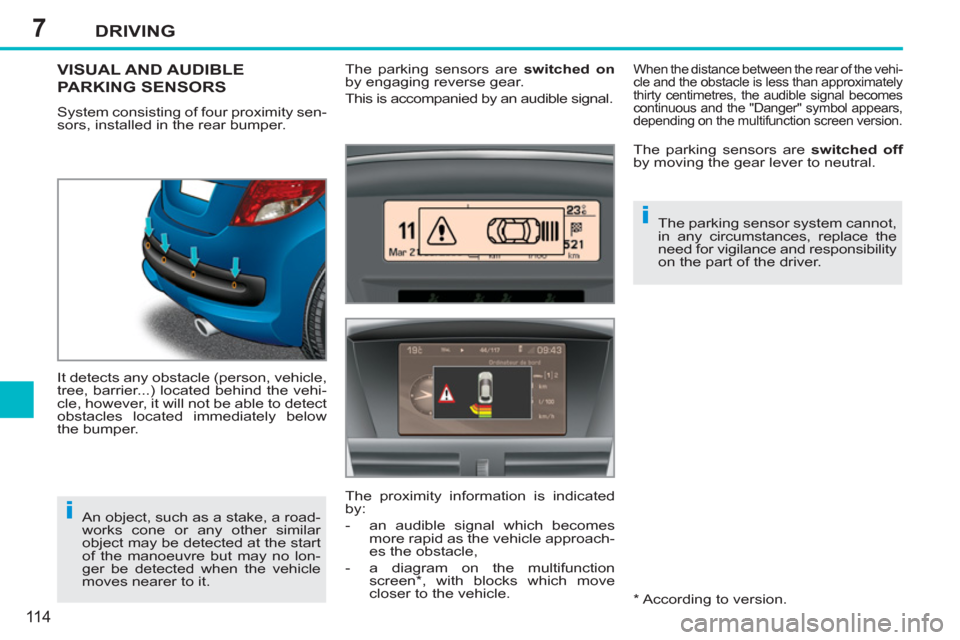
7
i
i
DRIVING
11 4
VISUAL AND AUDIBLE
PARKING SENSORS
System consisting of four proximity sen-
sors, installed in the rear bumper.
It detects any obstacle (person, vehicle,
tree, barrier...) located behind the vehi-
cle, however, it will not be able to detect
obstacles located immediately below
the bumper. The parking sensors are switched on
by engaging reverse gear.
This is accompanied by an audible signal.
*
According to version. An object, such as a stake, a road-
works cone or any other similar
object may be detected at the start
of the manoeuvre but may no lon-
ger be detected when the vehicle
moves nearer to it.
When the distance between the rear of the vehi-
cle and the obstacle is less than approximately
thirty centimetres, the audible signal becomes
continuous and the "Danger" symbol appears,
depending on the multifunction screen version.
The parking sensor system cannot,
in any circumstances, replace the
need for vigilance and responsibility
on the part of the driver. The parking sensors are switched off
by moving the gear lever to neutral.
The proximity information is indicated
by:
- an audible signal which becomes
more rapid as the vehicle approach-
es the obstacle,
- a diagram on the multifunction
screen * , with blocks which move
closer to the vehicle.
Page 122 of 224
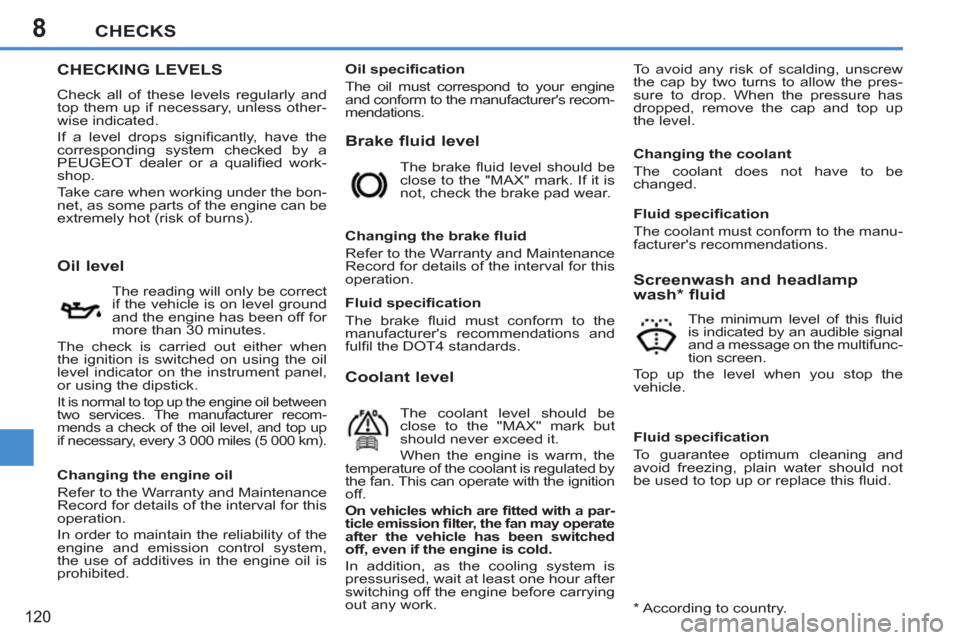
8CHECKS
120
CHECKING LEVELS
Check all of these levels regularly and
top them up if necessary, unless other-
wise indicated.
If a level drops signifi cantly, have the
corresponding system checked by a
PEUGEOT dealer or a qualifi ed work-
shop.
Take care when working under the bon-
net, as some parts of the engine can be
extremely hot (risk of burns).
Brake fluid level
To avoid any risk of scalding, unscrew
the cap by two turns to allow the pres-
sure to drop. When the pressure has
dropped, remove the cap and top up
the level.
Oil level
The reading will only be correct
if the vehicle is on level ground
and the engine has been off for
more than 30 minutes.
The check is carried out either when
the ignition is switched on using the oil
level indicator on the instrument panel,
or using the dipstick.
It is normal to top up the engine oil between
two services. The manufacturer recom-
mends a check of the oil level, and top up
if necessary, every 3 000 miles (5 000 km).
The brake fl uid level should be
close to the "MAX" mark. If it is
not, check the brake pad wear.
Changing the brake fl uid
Refer to the Warranty and Maintenance
Record for details of the interval for this
operation.
Coolant level
The coolant level should be
close to the "MAX" mark but
should never exceed it.
When the engine is warm, the
temperature of the coolant is regulated by
the fan. This can operate with the ignition
off.
On vehicles which are fi tted with a par-
ticle emission fi lter, the fan may operate
after the vehicle has been switched
off, even if the engine is cold.
In addition, as the cooling system is
pressurised, wait at least one hour after
switching off the engine before carrying
out any work.
Screenwash and headlamp
wash * fluid
The minimum level of this fl uid
is indicated by an audible signal
and a message on the multifunc-
tion screen.
Top up the level when you stop the
vehicle.
* According to country.
Changing the engine oil
Refer to the Warranty and Maintenance
Record for details of the interval for this
operation.
In order to maintain the reliability of the
engine and emission control system,
the use of additives in the engine oil is
prohibited.
Oil specifi cation
The oil must correspond to your engine
and conform to the manufacturer's recom-
mendations.
Fluid specifi cation
The brake fl uid must conform to the
manufacturer's recommendations and
fulfi l the DOT4 standards.
Changing the coolant
The coolant does not have to be
changed.
Fluid specifi cation
The coolant must conform to the manu-
facturer's recommendations.
Fluid specifi cation
To guarantee optimum cleaning and
avoid freezing, plain water should not
be used to top up or replace this fl uid.
Page 135 of 224

9PRACTICAL INFORMATION
133
Changing the integrated direction
indicator side repeaters
Changing the foglamp bulbs
For replacement of these bulbs, contact
a PEUGEOT dealer.
�)
Insert a screwdriver towards the
centre of the repeater between the
repeater and the base of the mirror.
�)
Tilt the screwdriver to extract the
repeater and remove the repeater.
�)
Disconnect the repeater connector.
To r efi t, carry out these operations in
reverse order.
To obtain a replacement repeater, contact
a PEUGEOT dealer.
Changing the sidelamp bulbs
�)
Disconnect the main headlamp
connector.
�)
Remove the plastic protective cover
by pulling on the tab.
�)
Turn the bulb holder one quarter of
a turn and remove it.
�)
Pull the bulb and change it.
To r efi t, carry out these operations in
reverse order.
Changing the dipped, main beam or
directional headlamp bulbs
�)
Disconnect the main headlamp
connector.
�)
Remove the corresponding plastic
protective cover by pulling on the tab.
�)
Disconnect the connector of the
corresponding lamp.
�)
Move aside the spring to release the
bulb and remove the bulb.
To r efi t, carry out these operations in
reverse order.
Page 138 of 224
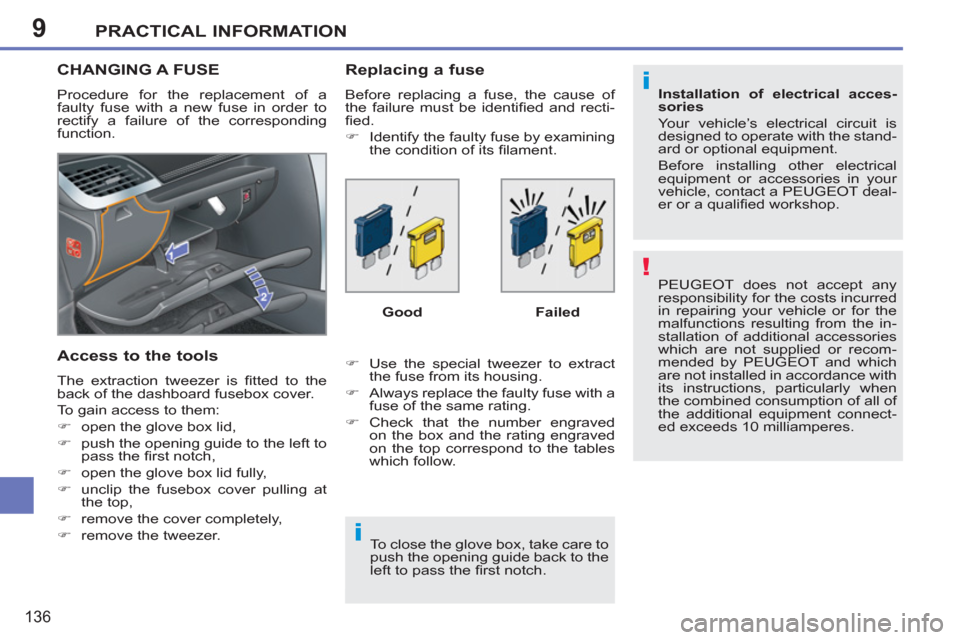
9
!
i
i
PRACTICAL INFORMATION
136
PEUGEOT does not accept any
responsibility for the costs incurred
in repairing your vehicle or for the
malfunctions resulting from the in-
stallation of additional accessories
which are not supplied or recom-
mended by PEUGEOT and which
are not installed in accordance with
its instructions, particularly when
the combined consumption of all of
the additional equipment connect-
ed exceeds 10 milliamperes.
Installation of electrical acces-
sories
Your vehicle’s electrical circuit is
designed to operate with the stand-
ard or optional equipment.
Before installing other electrical
equipment or accessories in your
vehicle, contact a PEUGEOT deal-
er or a qualifi ed workshop.
CHANGING A FUSE
Procedure for the replacement of a
faulty fuse with a new fuse in order to
rectify a failure of the corresponding
function.
Access to the tools
The extraction tweezer is fi tted to the
back of the dashboard fusebox cover.
To gain access to them:
�)
open the glove box lid,
�)
push the opening guide to the left to
pass the fi rst notch,
�)
open the glove box lid fully,
�)
unclip the fusebox cover pulling at
the top,
�)
remove the cover completely,
�)
remove the tweezer.
Replacing a fuse
Before replacing a fuse, the cause of
the failure must be identifi ed and recti-
fi ed.
�)
Identify the faulty fuse by examining
the condition of its fi lament.
�)
Use the special tweezer to extract
the fuse from its housing.
�)
Always replace the faulty fuse with a
fuse of the same rating.
�)
Check that the number engraved
on the box and the rating engraved
on the top correspond to the tables
which follow.
Good
Failed
To close the glove box, take care to
push the opening guide back to the
left to pass the fi rst notch.
Page 141 of 224
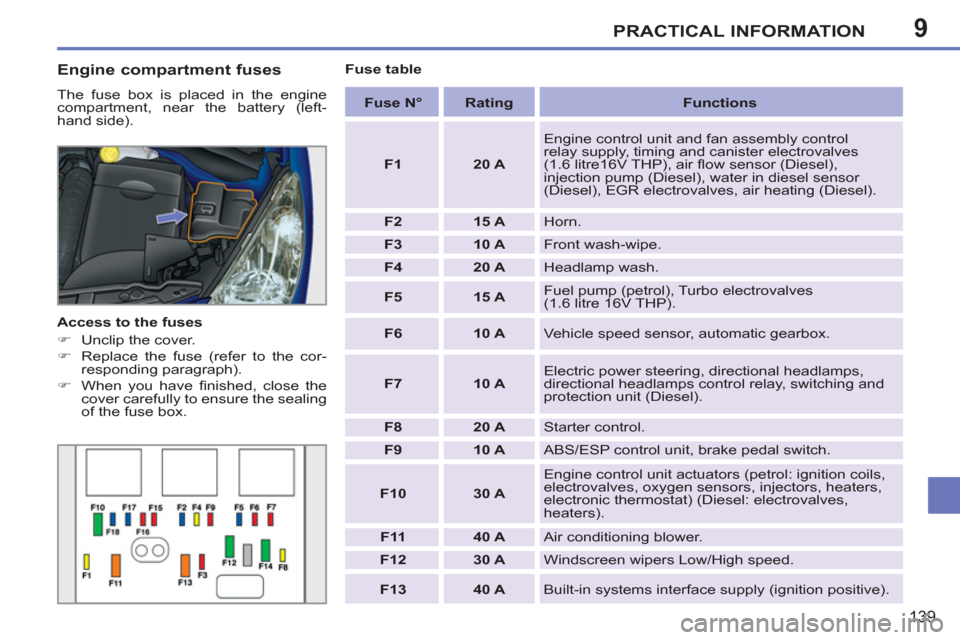
9PRACTICAL INFORMATION
139
Fuse N°
Rating
Functions
F1
20 A
Engine control unit and fan assembly control
relay supply, timing and canister electrovalves
(1.6 litre16V THP), air fl ow sensor (Diesel),
injection pump (Diesel), water in diesel sensor
(Diesel), EGR electrovalves, air heating (Diesel).
F2
15 A
Horn.
F3
10 A
Front wash-wipe.
F4
20 A
Headlamp wash.
F5
15 A
Fuel pump (petrol), Turbo electrovalves
(1.6 litre 16V THP).
F6
10 A
Vehicle speed sensor, automatic gearbox.
F7
10 A
Electric power steering, directional headlamps,
directional headlamps control relay, switching and
protection unit (Diesel).
F8
20 A
Starter control.
F9
10 A
ABS/ESP control unit, brake pedal switch.
F10
30 A
Engine control unit actuators (petrol: ignition coils,
electrovalves, oxygen sensors, injectors, heaters,
electronic thermostat) (Diesel: electrovalves,
heaters).
F11
40 A
Air conditioning blower.
F12
30 A
Windscreen wipers Low/High speed.
F13
40 A
Built-in systems interface supply (ignition positive).
Engine compartment fuses
The fuse box is placed in the engine
compartment, near the battery (left-
hand side).
Access to the fuses
�)
Unclip the cover.
�)
Replace the fuse (refer to the cor-
responding paragraph).
�)
When you have fi nished, close the
cover carefully to ensure the sealing
of the fuse box.
Fuse table
Page 142 of 224
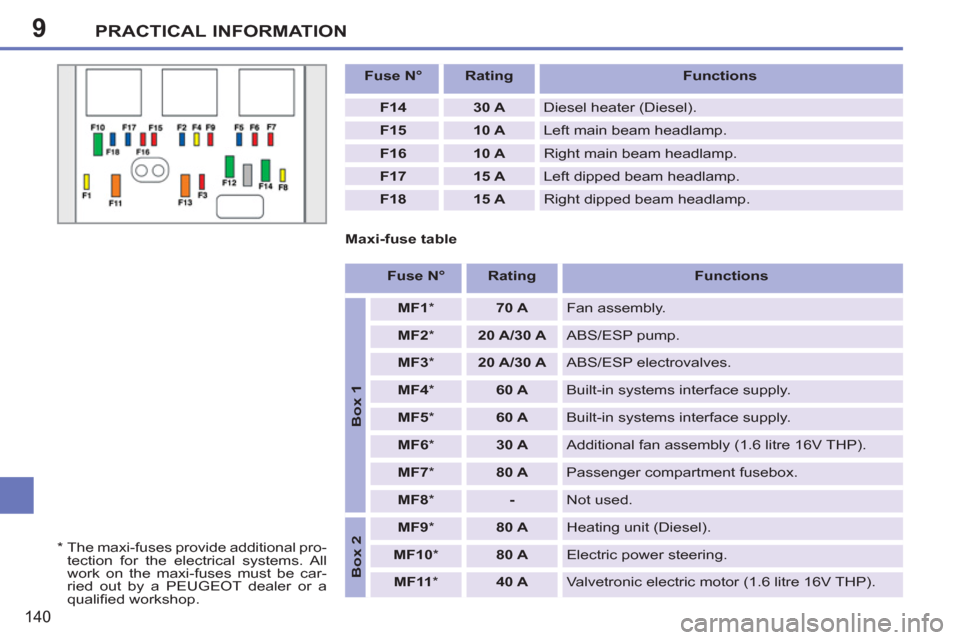
9PRACTICAL INFORMATION
140
Fuse N°
Rating
Functions
F14
30 A
Diesel heater (Diesel).
F15
10 A
Left main beam headlamp.
F16
10 A
Right main beam headlamp.
F17
15 A
Left dipped beam headlamp.
F18
15 A
Right dipped beam headlamp.
Fuse N°
Rating
Functions
Box 1
MF1
*
70 A
Fan assembly.
MF2
*
20 A/30 A
ABS/ESP pump.
MF3
*
20 A/30 A
ABS/ESP electrovalves.
MF4
*
60 A
Built-in systems interface supply.
MF5
*
60 A
Built-in systems interface supply.
MF6
*
30 A
Additional fan assembly (1.6 litre 16V THP).
MF7
*
80 A
Passenger compartment fusebox.
MF8
*
-
Not used.
Box 2
MF9
*
80 A
Heating unit (Diesel).
MF10
*
80 A
Electric power steering.
MF11
*
40 A
Valvetronic electric motor (1.6 litre 16V THP).
*
The maxi-fuses provide additional pro-
tection for the electrical systems. All
work on the maxi-fuses must be car-
ried out by a PEUGEOT dealer or a
qualifi ed workshop.
Maxi-fuse table
Page 144 of 224
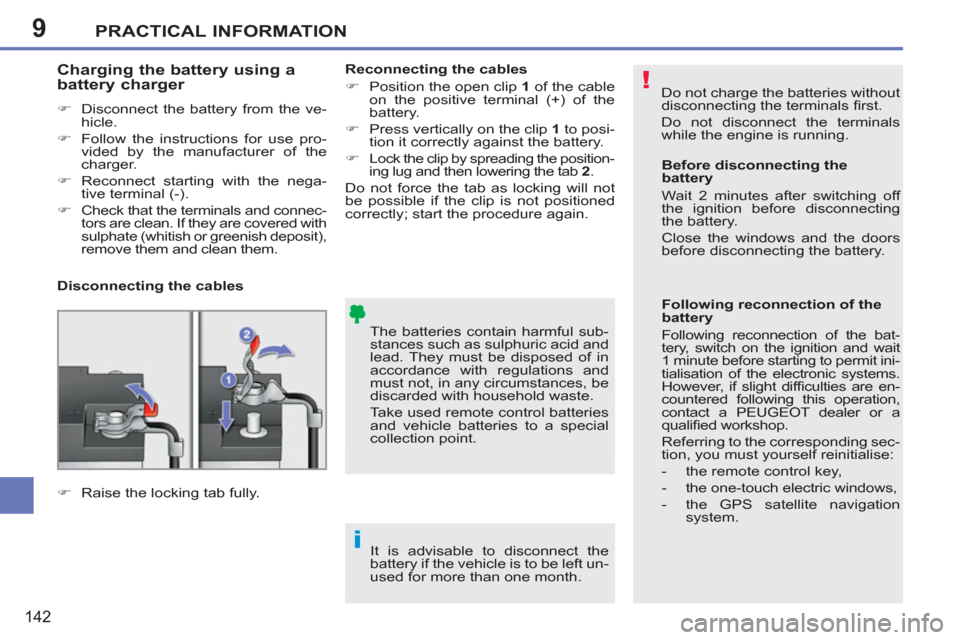
9
!
i
PRACTICAL INFORMATION
142
Do not charge the batteries without
disconnecting the terminals fi rst.
Do not disconnect the terminals
while the engine is running.
The batteries contain harmful sub-
stances such as sulphuric acid and
lead. They must be disposed of in
accordance with regulations and
must not, in any circumstances, be
discarded with household waste.
Take used remote control batteries
and vehicle batteries to a special
collection point.
Charging the battery using a
battery charger
�)
Disconnect the battery from the ve-
hicle.
�)
Follow the instructions for use pro-
vided by the manufacturer of the
charger.
�)
Reconnect starting with the nega-
tive terminal (-).
�)
Check that the terminals and connec-
tors are clean. If they are covered with
sulphate (whitish or greenish deposit),
remove them and clean them.
It is advisable to disconnect the
battery if the vehicle is to be left un-
used for more than one month.
Before disconnecting the
battery
Wait 2 minutes after switching off
the ignition before disconnecting
the battery.
Close the windows and the doors
before disconnecting the battery.
Following reconnection of the
battery
Following reconnection of the bat-
tery, switch on the ignition and wait
1 minute before starting to permit ini-
tialisation of the electronic systems.
However, if slight diffi culties are en-
countered following this operation,
contact a PEUGEOT dealer or a
qualifi ed workshop.
Referring to the corresponding sec-
tion, you must yourself reinitialise:
- the remote control key,
- the one-touch electric windows,
- the GPS satellite navigation
system.
Disconnecting the cables
Reconnecting the cables
�)
Position the open clip 1
of the cable
on the positive terminal (+) of the
battery.
�)
Press vertically on the clip 1
to posi-
tion it correctly against the battery.
�)
Lock the clip by spreading the position-
ing lug and then lowering the tab 2
.
Do not force the tab as locking will not
be possible if the clip is not positioned
correctly; start the procedure again.
�)
Raise the locking tab fully.